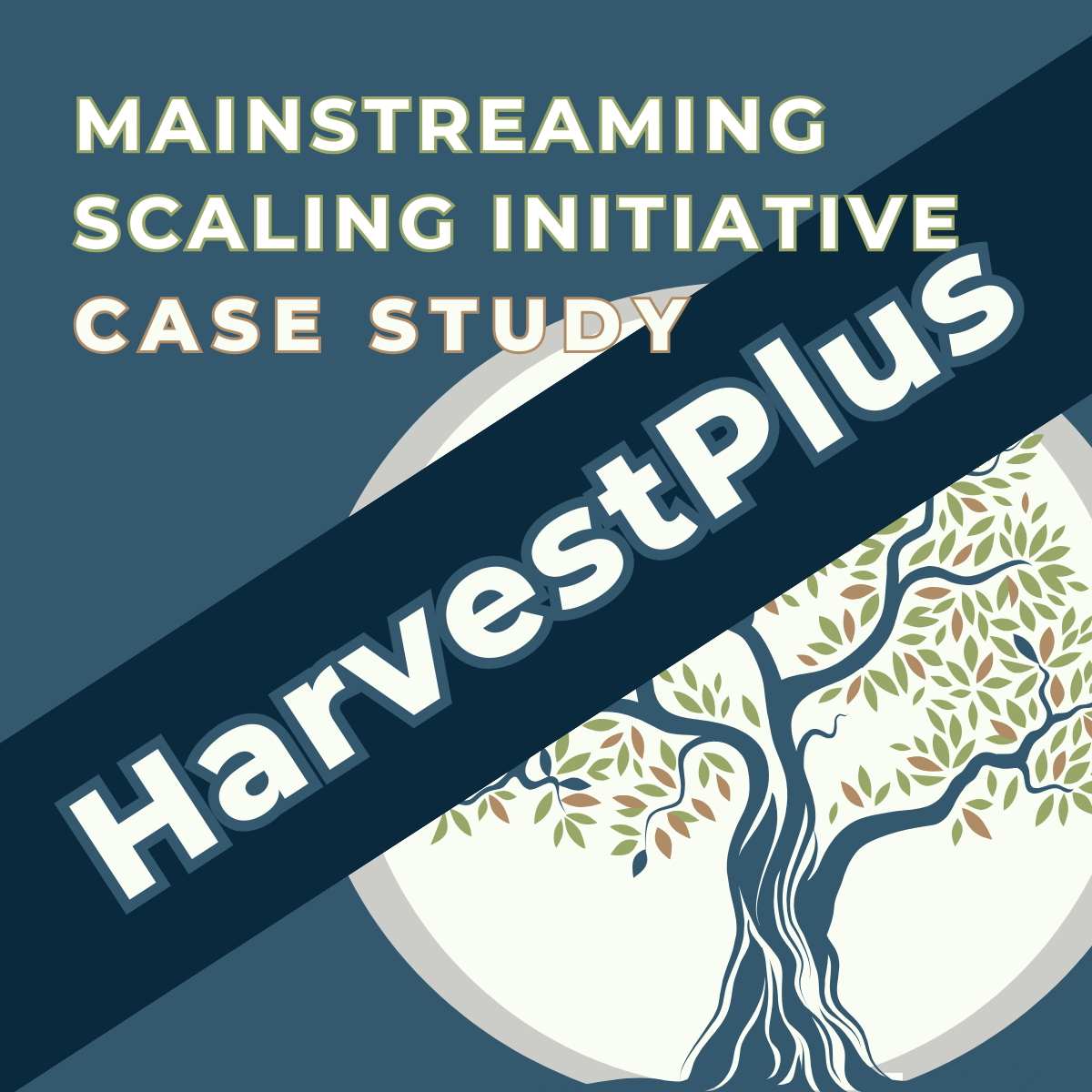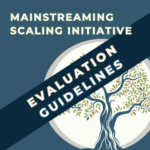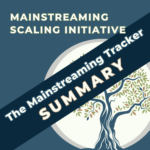Preface
The Scaling Community of Practice (CoP) launched an action research initiative on mainstreaming scaling in funder organizations in January 2023. This initiative has three purposes: to inform the CoP members and the wider development community of the current state of support for and operationalization of scaling in a broad range of development funding agencies; to draw lessons for future efforts to mainstream the scaling agenda in the development funding community; and to promote more effective funder support for scaling by stakeholders in developing countries. (For further details about the Mainstreaming Initiative, see the Concept Note on the COP website).
The Mainstreaming Initiative is jointly supported by Agence Française de Développement (AFD) and the Scaling Community of Practice (CoP). The study team consists of Richard Kohl (Lead Consultant and Project Co-Leader), Johannes Linn (Co-Chair of the Scaling CoP and Project Co-Leader), Larry Cooley (Co-Chair of the Scaling CoP), and Ezgi Yilmaz (Junior Consultant). MSI staff provide administrative and communications support, in particular Leah Sly and Gaby Montalvo.
The principal component of this research is a set of case studies of the efforts to mainstream scaling by selected funder organizations. These studies explore the extent and manner in which scaling has been mainstreamed, and the major drivers and obstacles. The case studies also aim to derive lessons to be learned from each donor’s experience, and, where they exist, their plans and/or recommendations for further strengthening the scaling focus.
The present case study focuses on the HarvestPlus. It was prepared by Jenny Walton, Benjamin Uchitelle-Pierce, Katharina Diehl and Lynn Brown of HarvestPlus (Innovation, Policy and Scaling Unit of the International Food Policy Research Institute). Johannes Linn and Richard Kohl provided comments and editorial support.
Introduction and Executive Summary
The genesis of the HarvestPlus program was the insight that everyone on the planet consumes one or more of the seven basic staple foods, in significant quantities, on a daily basis. (What the World Eats | National Geographic, n.d.) These staple foods can be improved with more micronutrients, by agronomic practices and nutritionally enriching the seeds. When implemented at scale, a revolution in food systems is ignited that will go a long way towards the eradication of hidden hunger.
Hidden hunger and the societal effects of being micronutrient malnourished is damaging to people and economies, the World Bank estimates costs of US$3 trillion a year, in the form of productivity loss, ranging from 3 to 16% (or more) of GDP in low-income settings (The World Bank and Nutrition. Nutrition Overview (Nutrition Overview (worldbank.org)). The triple burden of malnutrition, micronutrient malnutrition, underweight and overweight/obesity can lead to non-communicable diseases, including diabetes and cardio-vascular disease. These diseases are costly to people and costly to society in terms of health care costs. Obesity and hidden hunger can occur at the same time, micronutrient malnutrition is not just a problem for low-income settings, the problem of suboptimal nutrition status could be far worse than initially calculated.
Far more people are likely affected by hidden hunger than was previously thought. 1 in 2 children and 2 in 3 women worldwide likely have at least one micronutrient deficiency; many suffer from more than one. In some countries in Africa and Asia, 9 in 10 women are affected. 75% of all the preschool children affected live in Sub-Saharan Africa or east Asia and the Pacific (Beal et al., 2022). The prevalence of hidden hunger and micronutrient deficiencies worldwide, particularly in low- and middle-income countries (LMICs), has created a pressing need for effective solutions, such as biofortification. Biofortification, in the context of the HarvestPlus program, is a process that enriches everyday staple food crops with essential micronutrients such as iron, zinc, and vitamin A, through conventional breeding techniques or agronomic practices.
Hidden hunger co-exists in people who are overweight or obese. India now has more than 100 million people with diabetes (Anjana et al., 2023). A recent zinc study indicates a possible role for biofortification, specifically zinc, in addressing non-Communicable Diseases (Pompano & Boy, 2021) Hidden hunger is preventable. An integrated approach is needed that promotes diversified diets, behavior change where appropriate and other evidence-based actions like biofortification. The Copenhagen Consensus (Horton, Alderman, & Rivera 2008), a leading global development think tank, ranks biofortification (and other interventions that reduce micronutrient deficiencies) among the highest value-for-money investments for economic development: For every USD invested in biofortification, they estimate as much as 17 USD of benefits gained. Biofortification is aimed to switch the current staples that people eat with nutrient enriched varieties, reducing the need for behavior change communication. Biofortification can address multiple deficiencies within the same population. As of 2021, over six million farming households were consuming more of at least two priority nutrients, through a biofortified food basket approach (e.g., eating more iron and zinc, or more vitamin A and iron). By the end of 2023, the HarvestPlus program will have reached 100 million people in farming households and an additional 400 million in commercial markets. (HarvestPlus program monitoring and evaluation data 2023. Enriching 100 Million Lives – HarvestPlus)
Global nutrition challenges have driven the requirement to mainstream biofortification as one key viable solution to hidden hunger, given all populations eat staple foods and they are a significant component even of diversified healthy diets. These nutrient enriched crops make the food system more nutritionally resilient, with low fragility and long shelf lives. They also make people more nutritionally resilient. When shocks occur, incomes are reduced and consumers switch to low-cost staple foods, increasing the dominance of these foods in their diets. At the beginning of the HarvestPlus program in 2003 the mission was set to reach 1 billion people by 2030 with improved nutrient enriched foods, through increased biofortified planting materials and resulting crops, thus focusing on “scaling” as a strategic mission, long before it became a topic of the development community. (Table 1)
Table 1. HarvestPlus: Combining invention, innovation and intention to reach 1 billion consumers
| Invention | Innovation | Goal |
| Nutrient Enriched Crops through genetic biofortification | Multi point commercial and non-commercial delivery model with multiple innovations and technologies implemented at each step of the supply chain | 1 billion consumers by 2030 |
The primary funding partners of the HarvestPlus program, the UK’s FCDO (formally DFID) and the Bill and Melinda Gates Foundation (BMGF) shared the commitment to improve the nutrient content of staple foods to reduce the underlying causes of malnutrition. The donors recognized the potential scale of the approach and that it was most effective at reaching the poorest farmers who are difficult to reach with industrial fortification, given they do not purchase staple crops/foods. HarvestPlus funding partners also recognized that once these new staple crop varieties were bred and delivered it was largely self-sustaining, unlike industrial fortification and supplementation which have higher recurrent costs. The primary partners saw the vision of the HarvestPlus founder, Dr. Howarth Bouis, to make the plants do the work and improve the nutritional content of the food from agriculture, rather than processed food production.
The HarvestPlus program’s success is the combination of (1) high quality and market competitive biofortified planting materials (seeds/vines); (2) the development and execution of an effective delivery model; and (3) a clear strategy to scale and mainstream. Historically many agricultural interventions and new crop varieties have failed to achieve significant uptake. The programmatic approach of HarvestPlus considers the entire value chain, from plant breeding to seed production to crop production to food products to consumers, with a set of activities that stimulate and fulfil demand at each link in the supply chain. These activities, while largely commercial in nature, take into consideration non-commercial activities such as seed sharing, recycling of seed and delivery to consumers through institutional settings, such as social protection programs like school feeding. Partnerships at every step of the value chain, from policy makers to consumers, have contributed to the creation of a full food systems approach.
In 2023, the HarvestPlus project celebrates the 20th anniversary with the milestone achievement of reaching 100 million on farm consumers world-wide. This paper reviews the 20-year journey from the initial idea, the evolution, development and continual improvement of delivery and scaling models that will take the biofortification of staple foods to 1 billion consumers by 2030. With this aim in view, this paper will focus on achieving reach and scale, rather than the nutrition evidence of impact, which is published in separate papers Marshalling Evidence – HarvestPlus





